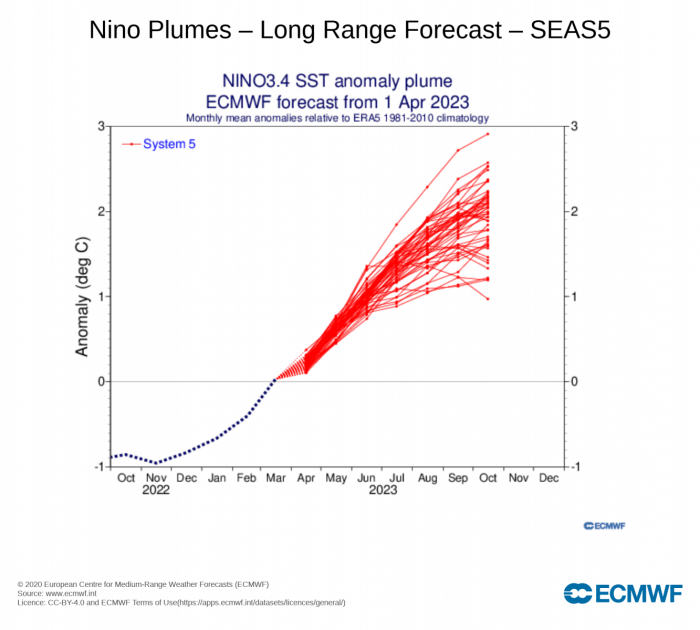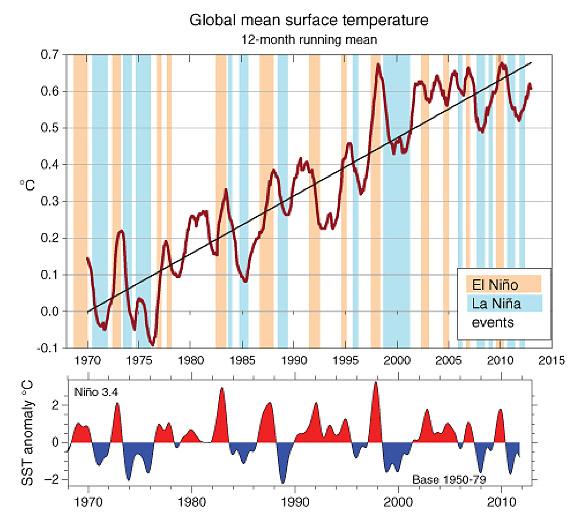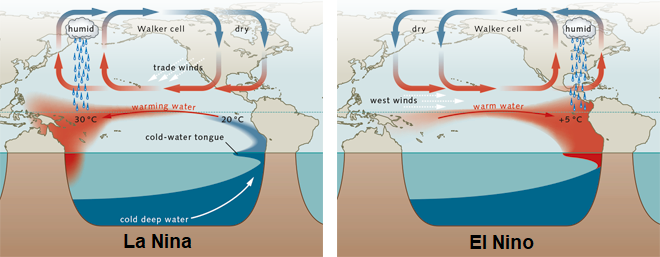
El Niño is set to return this year, and it could push the world past a new average temperature record with help from climate change induced global warming. The hottest year in recorded history, 2016, was driven by a very strong El Niño between 2015-16.
SSTs in ENSO region on the rise into El Nino territory next few months:

The last El Niño event took place in 2018/2019, and while this event was weak compared with 2015-16, 2019 and 2020 (along with 2016) were the top three warmest years on record globally. In the UK, the temperature reached 37.8C at Heathrow on 31st July 2020, making this the UK's third hottest day on record.
El Nino events have normally coincided with higher global temperatures, while La Nina has meant lower global temperatures, though in recent years the global temperatures have been steadily rising regardless of ENSO state. But El Nino may still bring higher temperatures than in La Nina in a generally higher base state.

El Niño is a warming of the ocean surface that brings above-average sea surface temperatures (SSTs) in the central and eastern tropical Pacific Ocean. Over Indonesia, rainfall tends to become reduced while rainfall increases over the tropical Pacific Ocean. The low-level surface winds, which normally blow from east to west along the equator instead weaken or, in some cases, start blowing the other direction (from west to east). During La Nina, the opposite happens and the central and eastern tropical Pacific undergoes a marked cooling.

After three years of the La Niña weather pattern, Australia's Bureau of Meteorology (BOM) analysis suggests that sea surface temperatures will cross the El Niño threshold this summer (southern hemisphere winter as stated in tweet below):
2022 was 5th-hottest year on record despite cooling La Niña conditions governing the tropical Pacific Ocean. During La Niña years, surface water temperatures in eastern parts of the central Pacific drop, which in turn results in wetter and cooler weather conditions across large portions of the world. Some parts of the world — including western Europe, the Middle East, Central Asia, China and north-western Africa saw their hottest 12 months in history.
In 2022, the planet was on average about 1.1C warmer than in the late 19th century, just 0.4C short of the threshold set by the global climate science community as a tipping point to avoid in order to prevent severe and unpredictable environmental consequences.
According to NOAA, global ocean heat content was at an all-time high in 2022, meaning that the overall amount of energy accumulated in the upper 6,500 feet (2,000 meters) of the world's globally connected ocean has never been higher. The increasing amount of heat is likely to exacerbate many negative effects of climate change, including sea level rise, further thawing of polar ice sheets and degradation of marine ecosystems.
El Niño is normally associated with record breaking temperatures across the globe. As El Nino is forecast to develop during summer, it is less likely the record for global temperatures will be challenged until 2024. There is usually a lag response of the atmosphere to ocean temperatures, so La Nina will still likely have an imprint for a while yet until the effects of El Nino imprint on the atmosphere takes hold.
But is possible that the next big El Niño could take us over the 1.5 °C target, which is the goal of the Paris Agreement, which calls for countries to take concerted climate action to reduce greenhouse gas emissions in order to limit global warming.
There is a 50:50 chance of average global temperature reaching 1.5 degrees Celsius above pre-industrial levels in the next five years, and the likelihood is increasing with time, according to a new report by the World Meteorological Organization (WMO), published in May 2022 in Geneva.
The strength of the developing El Nino is still unclear, many models are forecasting a moderate El Nino event from summer this year, but we should get a better picture by June.
El Niño also influences the Atlantic and Pacific hurricane seasons, usually leading to fewer tropical storms and hurricanes in the Atlantic and more than average in the Pacific. In the case of the Atlantic, El Niño increases vertical wind shear—the change in wind direction and strength from the surface to higher in the atmosphere—which can impede a hurricane’s growth.
The most at-risk areas include south east Asia, India, Australia, parts of the Amazon and southern Africa. For example, more extreme heat, drought and fires are likely in eastern Australia during El Nino, the opposite of the flooding seen recently as a result of La Nina.
Although for the UK, there is less direct impact from El Niño. The UK may not see any dramatic temperature rises this year, but El Nino could result in higher temperatures next year, more particularly in summer. But on the other hand, studies have linked El Nino to colder winters in northern Europe, due to low pressure over Iceland and high pressure over the Azores losing strength -leading to the jet stream tracking further south than normal – bringing wetter conditions to southern Europe and cooler, drier conditions to northern Europe. Whether global warming will affect this typical winter response over Europe remains to be seen though.
In the nearer term, i.e. as we head into summer when we are likely to transition into El Nino, which like 2015 which saw a strong El Nino develop, we could see a wet summer, but not necessarily without some hot spells as well.
Loading recent activity...